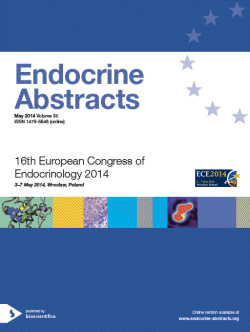Poster Presentations
Growth hormone IGF axis basic
ea0035p668 | Growth hormone IGF axis basic | ECE2014
Effects of partial deficiency of IGF1 on hepatocellular architecture
Lara Victor Javier , Munoz Ursula , Puche Juan Enrique , Garcia-Magarino Mariano , Lavandera Jose Luis , Castilla-Cortazar Inma
ea0035p669 | Growth hormone IGF axis basic | ECE2014
Mechanism of hepatoprotection derived from IGF1 replacement therapy
Munoz Ursula , Lara Victor Javier , Puche Juan Enrique , Sadaba Maria Cruz , Olleros Maria , Martin Irene , Castilla-Cortazar Inma
ea0035p670 | Growth hormone IGF axis basic | ECE2014
Young female with acromegaloid features, pituitary macroadenoma, and an uncomplicated pregnancy
Figueroa Carlos , Santiago Monica , Hernan Jose , Mangual Michelle , Gutierrez Madeleine , Palermo Coromoto , Trinidad Rafael , Sanchez Alfredo , Miranda Maria DeLourdes
ea0035p671 | Growth hormone IGF axis basic | ECE2014
Epigenetic regulation of GH target genes and its relation to in vivo GH signaling in skeletal muscle of adult human males: a pilot study
Pedersen Morten H , Vestergaard Poul F , Switnicki Michal , Jessen Niels , Jorgensen Jens O L
ea0035p672 | Growth hormone IGF axis basic | ECE2014
Demographic and clinical characteristics and treatment patterns of polish acromegalic patients switched to lanreotide AUTOGEL 120
Orlewska Ewa , Kos-Kudla Beata , Sowinski Jerzy , Sworczak Krzysztof , Zgliczynski Wojciech
ea0035p673 | Growth hormone IGF axis basic | ECE2014
Incidence and late prognosis of acromegaly in Denmark: preliminary data
Dal Jakob , Feldt-Rasmussen Ulla , Andersen Marianne , Kristensen Lars , Laurberg Peter , Sorensen Henrik , Jorgensen Jens Otto
ea0035p674 | Growth hormone IGF axis basic | ECE2014
Pollution agents contribution in goitrogenous process in dobrogea: the Southeastern boundary of Romania
ea0035p675 | Growth hormone IGF axis basic | ECE2014
The etiologies of growth hormone insufficiences: about 170 cases
Fedala Soumeya , Haddam Ali El Mahdi , Chentli Farida , Zenati Akila , Brue Thierry , Amselem Serge , yaker Fetta
ea0035p676 | Growth hormone IGF axis basic | ECE2014
GH replacement therapy affects the morphology and function of the left ventricle in patients with adult-onset GH deficiency
Dlesk Anton , Kamensky Gabriel , Lazurova Ivica , Kuzma Martin , Jackuliak Peter , Payer Juraj
ea0035p677 | Growth hormone IGF axis basic | ECE2014
Positive impact of GH treatment on trabecular bone using grey-level texture analysis
Kuzma Martin , Kuzmova Zuzana , Vanuga Peter , Killinger Zdenko , Payer Juraj
ea0035p678 | Growth hormone IGF axis basic | ECE2014
Analysis of bioactive IGF-binding proteins by quantitative western ligand blotting in different biological fluids for biomarker research
Wirthgen Elisa , Hoeflich Christine , Muller Steffen , Metzger Friedrich , Hoeflich Andreas
ea0035p679 | Growth hormone IGF axis basic | ECE2014
Latest results from the PATRO Adults study of Omnitrope® for the treatment of adult patients with GH deficiency
Beck-Peccoz Paolo , Hoybye Charlotte , Murray Robert D , Simsek Suat , Leal-Cerro Alfonso , Minuto Francesco , Zabransky Markus , Stalla Gunter
ea0035p680 | Growth hormone IGF axis basic | ECE2014
Increased relative amount of visceral and subcutaneous adipose tissue in long-lived GH-releasing hormone knockout (GHRHKO) mice; is it beneficial or not?
Gesing Adam , Masternak Michal , Boparai Ravneet , Lewinski Andrzej , Karbownik-Lewinska Malgorzata , Salvatori Roberto , Bartke Andrzej
ea0035p681 | Growth hormone IGF axis basic | ECE2014
Effects of two mTOR inhibitors on in-vitro models of GH-secreting pituitary adenomas
Bellio Mariaenrica , Gagliano Teresa , Zatelli Maria Chiara , Uberti Ettore Degli
ea0035p682 | Growth hormone IGF axis basic | ECE2014
Evaluation of the effect of X chromosome abnormalities on the response to GH therapy in children with turner syndrome
Kasprzyk Jakub , Wlodarczyk Marcin , Sobolewska Aleksandra , Glusinska Sylwia , Stawerska Renata , Hilczer Maciej , Lewinski Andrzej
ea0035p683 | Growth hormone IGF axis basic | ECE2014
The pathophysiology of increased hepatic IGF1 expression in an ovine model of polycystic ovary syndrome
Siemienowicz Katarzyna , Boswell Lyndsey , Carr David , Mina Theresia , Connolly Fiona , Rae Mick , Duncan Colin




